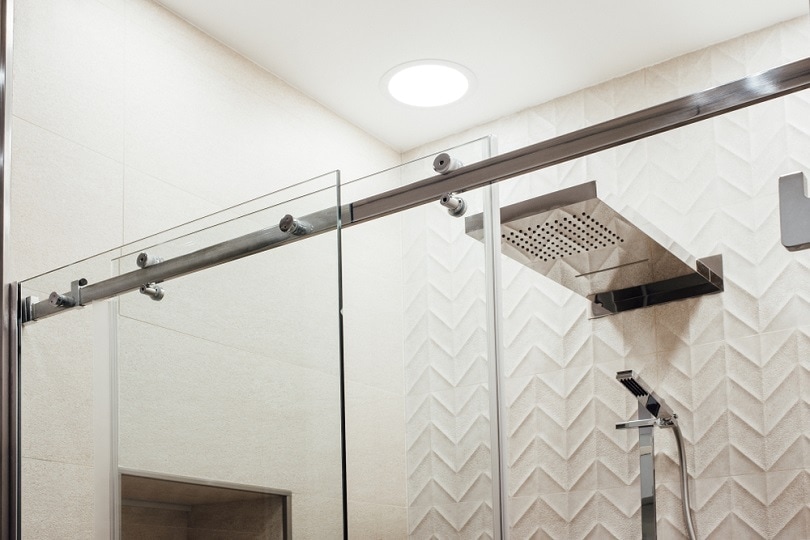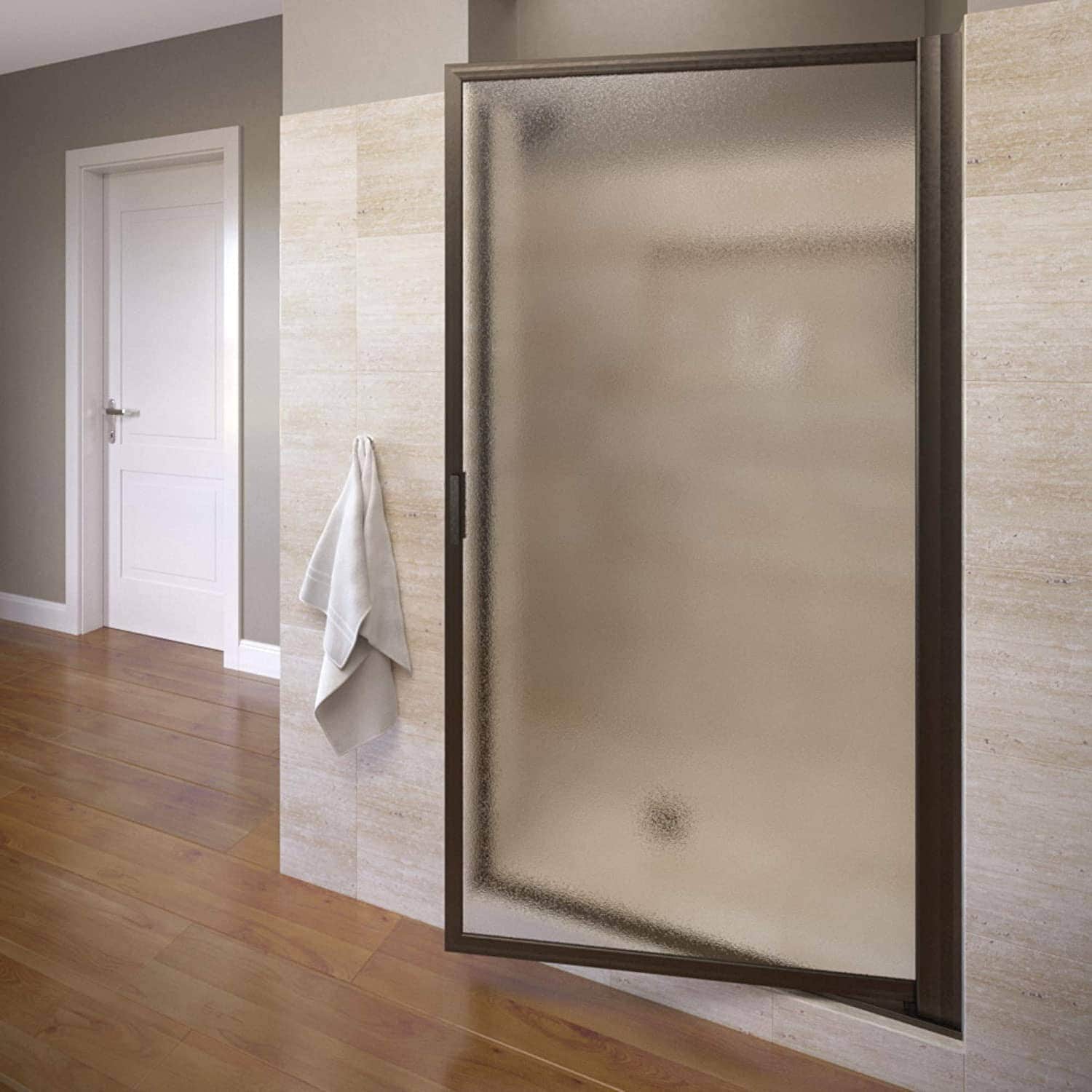9 Types of Shower Doors and Their Differences (with Pictures)
-
- Last updated:

Whether you are building a new custom shower or you’re just remodeling, one of the most important decisions you’ll make during the process is what type of shower door you’re going to install. The wrong choice here can ruin the overall look of your shower and bathroom.
However, the right shower door can truly enhance your shower, transforming it into a unique and beautiful work of art. Each type of shower door has its own unique appearance that can fit different tastes. Some are intended for specific shower designs, such as those built into a corner. There are pivot shower doors, as well as doors that slide and hinge. Some have metal frames that surround the glass while others are completely frameless.
With so many types of shower door options to choose from, it can start to get overwhelming. Don’t worry, we have broken down nine different types of shower doors so that you can understand the differences between each of them.
The 9 Types of Shower Doors
1. Framed Shower Doors

This is the standard type of shower door that most of us are familiar with. They’re cost-effective and easier to install than frameless doors. In fact, homeowners with some DIY experience may even be able to install them themselves. Framed setups can be sliding doors, hinged doors, or pivot shower doors. A framed shower door has a metal frame that goes all the way around the perimeter to provide strength and stability. While it does this job well, it comes with an unintended side effect. The metal used for the frame can detract from the overall looks of the shower.
- Cost-effective
- Easier to install
- Multiple styles to choose from
- The metal frame isn’t visually appealing
2. Frameless Shower Doors

Simple yet elegant, frameless shower doors are almost entirely glass. With no metal frame around the perimeter, they’re not only attractive, but they’re also difficult to install. They can be sliding doors, hinged doors, or pivot shower doors. The glass used for these doors is very thick since there is no frame to add strength and stability. The glass must be able to support its own weight by whatever method it’s mounted. Naturally, they’re more expensive than framed shower doors because of this, but also because of how aesthetically pleasing they are. Since they are more difficult to install, you’ll likely need to hire a professional.
- Elegant looks
- No frame to distract from the shower behind
- More expensive
- Difficult to install
- You might also like: 10 Best Cleaners for Glass Shower Doors – Our Reviews & Top Picks
3. Sliding Shower Doors

Also known as bypass doors, sliding shower doors work similarly to a sliding patio door, except that both panels will slide so you can enter your shower from either side. In a framed system, the doors are contained inside of tracks in the frame. For a frameless setup, a metal track bar is mounted across the top of the front of the shower enclosure. The glass panels will hang on the track bar with rollers that will slide across the bar with ease. This type of shower door can be pretty difficult to install though, so you may want to consider contacting a professional. Remember that sliding doors can only be used on showers with a large enough opening for two full-size glass doors to fit. Smaller shower entryways won’t be able to use a sliding door.
- Can enter from either side
- Frameless or framed
- Difficult to install
4. Hinged Shower Door

Available in both framed and frameless designs, shower doors on hinges work just like normal hinged doors. They swing open into the bathroom to allow entry. This will limit space in the bathroom, but it’s also very versatile. Hinged shower doors can be used on large shower openings with a dead panel, or they can be used in very small openings without one. The hinges can be mounted directly to the shower wall or even to a stationary panel of glass.
- Framed or frameless
- Works on many types of showers
- Swings into the bathroom, taking up space
5. Pivot Shower Door

Similar to a hinged shower door, pivot shower doors operate on a hinge system. The big difference is that pivot shower doors can fully open in either direction. Hinges on a pivot shower door can be mounted on one side of the panel just like hinged doors. Alternatively, a center pivot can be used, which essentially turns it into a revolving door. Keep in mind that pivot shower doors tend to be a bit more expensive than ones with regular hinges.
- Can open either direction
- Can be framed or frameless
- Can be quite expensive
6. Bi-Fold Shower Doors

When dealing with compact spaces, bi-fold shower doors can help you to make the most of what you’ve got. They’re sort of a mix between a sliding door and a hinged door. When you open the door, the center hinges back into a V, while the handle side of the door slides towards the hinged side, opening fully and folding flat against the hinged side. These are great for narrow shower openings, but can also be used on wider openings as well. Bi-fold shower doors are only available framed since they require the support of the railing to operate.
- Great for small openings
- Doesn’t take up much space when it opens
- Only available framed
7. Neo-Angle Door

Neo-angle doors are glass enclosures that surround a corner-built shower. With two finished shower walls, one on each side of the corner, the glass is used to create a total of five sides, including the door. One stationary glass panel is attached to either end of the shower walls. A third glass panel, which will operate as a door, is used to bridge the gap from the two stationary panels, enclosing the entire shower. The door panel makes up the entire front wall of a neo-angle setup. These types of shower doors give an unfettered view of the shower walls behind, so they’re excellent at showing off custom tile work. You also have less tile work to do since three of your walls will be made from glass. It’s an elegant look, but it can be pretty expensive. It’s also much more difficult to install than a regular shower door, so you’ll likely be enlisting the help of a professional.
- Less shower to build
- The wide-open look shows off the shower
- Elegant design
- Can be an expensive option
- Difficult to install
8. Steam Door

Steam doors are intended to reach all the way from floor to ceiling, completely enclosing the entire shower area. They must be sealed on every edge so that the shower enclosure is airtight. This enables steam to build up inside, effectively turning your shower into a steam room. These are much more expensive shower door options than most other types of shower doors. You’ll also need a professional to take care of this one, which means an even higher cost when you factor in installation.
- Completely sealed
- Turns shower into a steam room
- Much more expensive
- Requires professional installation
9. Curved Shower Door

These are a newer shower door option that can really make your bathroom stand out. A curved shower door curves across the front of your shower enclosure, just as the name implies. This provides extra space inside your shower, though it takes up more space inside your bathroom. It’s also one of the most expensive shower door options since the glass and metal used for it must all be curved as well.
- Luxurious looks
- Provides extra shower space
- Very expensive option
- Reduces bathroom space
•You might also like:What Is a Half Bath? Different Types of Bathrooms, Explained

Conclusion
Picking the type of shower door you intend to use on your shower is just as important as the type of tile you build it from. If you pick the wrong door, you could completely ruin the look you were hoping to achieve. There are many different shower door options on the market, and they vary widely in price, aesthetics, ease of installation, and what type of shower design they’ll even work with. Make sure you take some time to carefully plan out your shower entryway. Don’t leave it as a last-minute decision. The entire character of your bathroom hinges on your choice of shower door.
See Also:
Featured image credit: ErikaWittlieb, Pixabay
Contents

